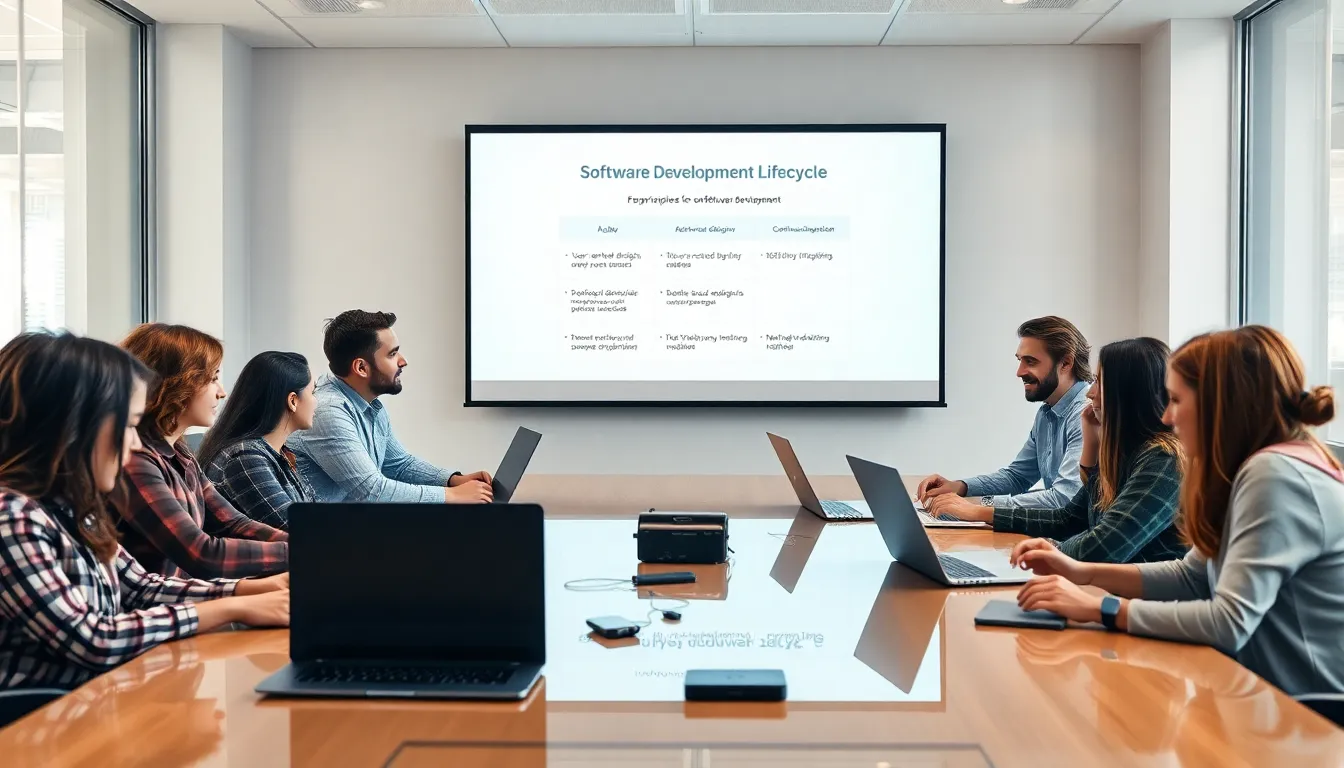Table of Contents
ToggleWhen it comes to technology, the lines can blur faster than a developer can fix a bug. “Software Development” and “Software Engineering” sound like they might be the same thing, don’t they? Spoiler alert: they’re not. Each term comes with its own set of complexities, essential principles, and a unique approach to creating the software that powers our world. So grab your coffee and fasten your seatbelt, as this article dives into the nitty-gritty differences between these two realms. You might even learn something new, or at least be entertained.
Understanding Software Development

Software development is the process of designing, coding, testing, and maintaining software. It’s the creation of applications and systems that make our digital lives more efficient. But before you decide to don a cape and call yourself a hero of code, let’s dig into the key principles and processes that are the backbone of software development.
Key Principles of Software Development
At its core, software development revolves around several key principles. These include user-centered design, agile methodologies, and continuous integration. User-centered design ensures that the software is built with the end-user in mind, while agile methodologies promote flexibility and iterative improvement. Continuous integration allows developers to regularly merge their code changes into a central repository, reducing the risk of integration issues.
Software Development Life Cycle (SDLC)
The Software Development Life Cycle (SDLC) is a framework used to describe the different stages of software development. It generally includes the following phases:
- Planning: Identifying the requirements for the project.
- Design: Laying out how the software will function and look.
- Implementation: The actual writing of code.
- Testing: Ensuring the software works as intended.
- Deployment: Making the software available for users.
- Maintenance: Updating and fixing the software post-launch.
Understanding each phase is crucial for a successful project, as is the ability to adapt between them.
Roles and Responsibilities in Software Development
In software development, team roles can vary significantly based on the size and type of project. Typically, one would encounter a mix of the following roles:
- Software Developers: They handle coding and problem-solving.
- Project Managers: They oversee the project’s timeline and budget, making sure everything runs smoothly.
- Testers: They focus on finding bugs and ensuring quality control before the software hits the market.
- UX/UI Designers: They design intuitive user interfaces and experiences to keep users happy. Each role contributes to a collaborative environment, relying on effective communication to deliver a top-notch product.
Understanding Software Engineering
Software engineering is a broader field that incorporates principles from computer science and focuses on the systematic design, development, maintenance, use, and management of software applications. It combines technical expertise with an understanding of project management and user needs.
Core Principles of Software Engineering
Software engineering is rooted in several core principles, such as modularity, abstraction, and reusability. Modularity enables developers to break down complex software into smaller, manageable pieces. Abstraction helps to reduce complexity by hiding irrelevant details, while reusability encourages the use of existing code, boosting efficiency. Understanding these principles is key to ensuring high-quality software products.
Software Engineering Process Models
Software engineering also employs various processes or models, including the Waterfall model, Iterative model, and Agile model. The Waterfall model follows a linear approach, while the Iterative model allows for revisiting earlier stages. Agile focuses on flexibility and collaboration, making it an increasingly popular choice in fast-paced environments. Each model has its strengths and weaknesses, making it vital for engineers to choose the right approach for each unique project.
Roles and Responsibilities in Software Engineering
In software engineering, roles are similarly diverse but often require a more extensive range of technical and analytical skills. Here’s a quick breakdown:
- Software Engineers: They design and carry out systems, often involving deeper mathematical and theoretical principles than typical developers.
- Systems Analysts: They bridge the gap between business needs and technical solutions, ensuring that the software meets operational objectives.
- Architects: They define the high-level structure of the software, making decisions about platforms, languages, and design patterns.
- DevOps Engineers: They combine development with operations, focusing on ensuring the software can be reliably deployed and maintained.
Comparative Analysis: Software Development vs Software Engineering
Understanding the differences between software development and software engineering is crucial for anyone navigating the tech world.
Differences in Methodologies
While both fields aim to produce software, their methodologies differ considerably. Software development is often project-focused and can use various frameworks, sometimes leading to a more chaotic process. In contrast, software engineering leans heavily on structured frameworks and models, ensuring the project aligns with both user needs and technical requirements.
Impact on Final Deliverables
The final deliverables also differ. Software developed through agile methods may prioritize speed and innovation, resulting in software that might not always be thoroughly tested. On the other hand, software engineering aims for longevity and scalability, focusing on creating robust applications that can evolve with user requirements and technological changes.
Career Path and Skills Required
For those looking to jump into either software development or software engineering, understanding the required skill sets and career paths can be enlightening.
- In Software Development: Skills like proficiency in programming languages, problem-solving abilities, and experience with version control systems (like Git) are key. Many developers start with an associate degree or bootcamp education.
- In Software Engineering: A strong grasp of algorithms, data structures, and system design is essential. Typically, software engineers hold a degree in computer science or a related field. Also, familiarity with methodologies like Agile is often a critical differentiator.
Future Trends in Software Development and Engineering
Both software development and engineering are rapidly evolving as technology advances. Currently, trends such as cloud computing, artificial intelligence, and distributed systems significantly reshape how applications are developed and maintained. The rise of low-code and no-code platforms is making software development more accessible, allowing more individuals to participate in the creation process. Meanwhile, software engineering is leaning more towards DevOps practices, enhancing collaboration between developers and operations teams to improve efficiency and deployment.




